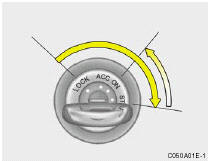Starting

Starting
WARNING:
Never run the engine in a closed or poorly
ventilated area any longer than is needed to
move your car in or out of the area. The
carbon monoxide gas emitted is odorless
and can cause serious injury or death.
Normal Conditions:
The Starting Procedure: 1. Insert key, and fasten the seat belt.
2. Depress the clutch pedal fully and place the gearshift lever (manual transaxle) in neutral or the selector lever (automatic transaxle) in "P" (park) position.
3. After turning the ignition key to the "ON" position, make certain all warning lights and gauges are functioning properly before starting the engine.
WARNING:
Be sure that the clutch is fully depressed
when starting a manual transaxle vehicle.
Your manual transaxle equipped vehicle will not start unless the clutch pedal is fully depressed.
4. Turn the ignition key to the "START" position and release it when the engine starts.
After the engine has started, allow the engine to run for 10 to 20 seconds prior to placing the vehicle in gear.
The starter should not be operated for more than 15 seconds at a time. Wait 15-30 seconds between starting attempts to protect the starter from overheating.
WARNING:
Always fully depress the brake pedal before
and while shifting out of the "P" Park position
into another position to avoid inadvertent
motion of the vehicle which could
injure persons in or around the car.
See also:
Securing the Child Restraint Seat with the "Child Seat Lower Anchor" system
Some child seat manufacturers make safety seats that are labeled as LATCH or
LATCH-compatible child seats. LATCH stands for "Lower Anchors and Tethers for Children".
These seats includ ...
FLUIDIC SCULPTURE DESIGN
The 2012 Hyundai Accent joins the Hyundai line-up sporting the company's
increasingly popular "Fluidic Sculpture" design. The vehicle's exterior lines
are intended to be futuristic, dyna ...
Power Steering Pump, Belt and Hoses
Check the power steering pump and hoses for leakage and damage. Replace any damaged
or leaking parts immediately. Inspect the power steering belt for evidence of cuts,
cracks, excessive wear, oili ...


